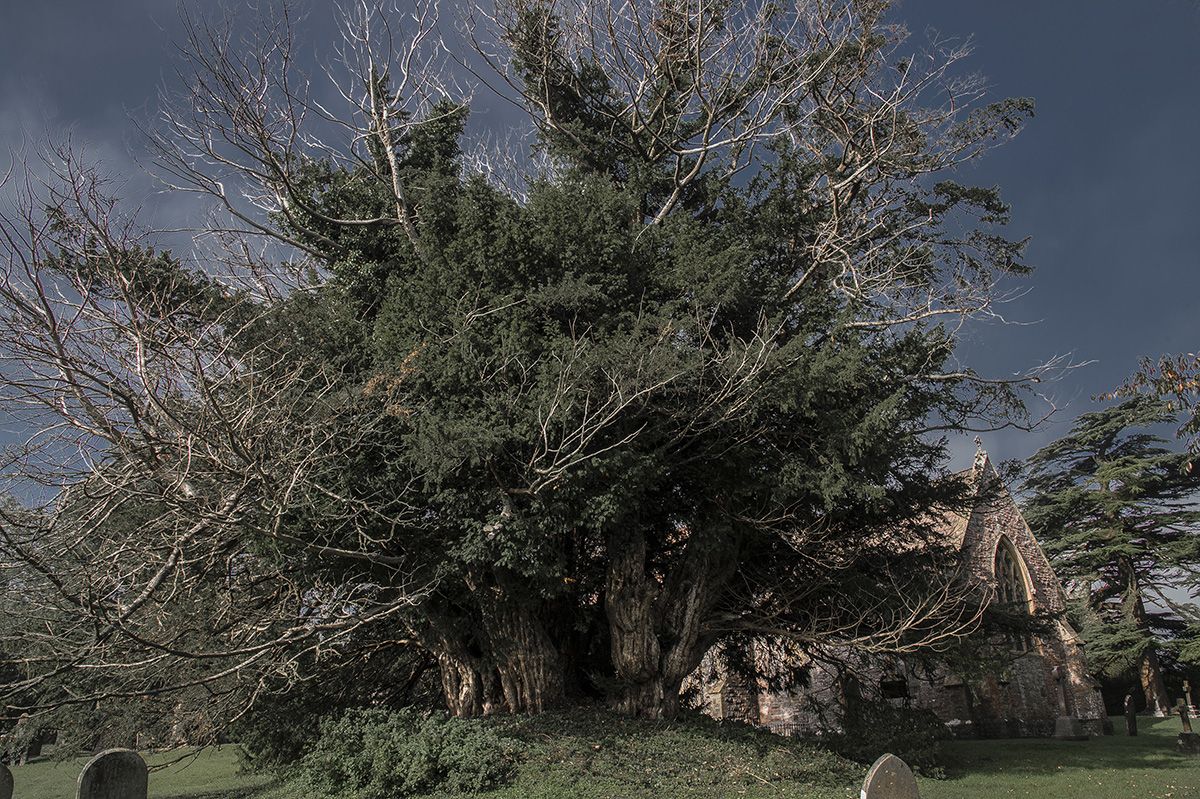Tree time is slow time. Stand by an old tree for a while and watch how your fast, animal body responds. Your breath lengthens, your heart rate drops, your shoulders relax. It seems that the tree is urging you, ever so gently and on the sly, to step into the same slow river in which it exists – a river so glacial that to our restless human eyes it appears rock solid.
The longest-lived of all native British trees is the yew, Taxus baccata. There are around 330 ancient yews in the country – that is trees over 1,000 years old. Of these, 60 are more than 2,000 years old and just 10 have crossed the three-millennia mark. One of these lives eight miles from my house in the small village of Ashbrittle on the Somerset/Devon border.
It is surprisingly little known hereabouts, and even in the yew literature it is not much referenced: far more column inches are devoted either to the oldest yew – thought to be the 5,000-year-old yew at Fortingall in Perthshire – or the most historically significant, the Ankerwyke Yew in Berkshire, beneath which (or so it is said) King John signed the Magna Carta in 1215.
The Ashbrittle Yew is thought to be over 3,000 years old – the kind of age that stops you in your tracks. A friend of mine, who lives in the village, agreed to introduce us.
A small weather-beaten sign stands on the village green, pointing “To the church & yew tree”. My friend bids me wait a moment at the gateway to the churchyard. “We’ll ask permission before we go in,” she says. “It’s only polite.” We stand, listening, me a little bemused. A robin sends out a trilling song. The breeze lifts a branch. She nods: we have been given the all-clear.
The Ashbrittle Yew pre-dates the church by at least 2,000 years. Over the centuries, it has hollowed and split, creating a circle of seven trunks, each as massive as a full-grown tree, the whole thing lifted up on a raised dome of earth 12 metres in diameter, as though it has, by sheer, slow force, built its own pedestal to rest upon. Legend has it that the raised tumulus is in fact a Bronze Age or even Neolithic burial mound, or perhaps where the skulls of tribal warriors lay buried by the invading Romans. Red-stained bones found near the base perhaps indicate pagan rituals and rites.
The dense, evergreen crown is pierced with spikes of dead branches, bleached white by the sun, whose skeletal aspect adds to the tree’s other-worldly aura. The spirit of the yew is said to be half-human, half-bird and has been seen – or so they say – around these parts.
Tucked into the fissures and hollows are votive offerings: a small plastic flower, a painted pebble, a screw of paper. Hopes, prayers, blessings. In one place, a small section of bark lies on the ground. Above it, the exposed piece of sapwood glows silky red, like fresh scar tissue, already healing. I place the bark piece back on the trunk and it fits, neat as a jigsaw piece, like an island on the map of the world.
The yew seems to stand at a crossroads – some see a killer, others a healer, angel or devil. Every part of this tree is poisonous, except the bit that looks like it really should be: the bright red berry-like aril that bears its seed. And yet the very chemical that makes it toxic – Taxin B – is now used to treat cancer.
Engraved on a stone in the shade of its branches are the words “I am the resurrection and the life”, a sentiment that applies as much to the tree itself, with its extraordinary powers of regeneration, as the figure on the cross. Fred Hageneder makes a strong case for Yggdrasil, the tree of life and axis mundi of Norse mythology, being a yew. In Anglo-Saxon, he notes, ih means both ‘I’ (the conscious self) and the yew tree; in Old High German the word for yew, eo, also means ‘eternal’ and ‘always’. “Somehow,” he writes, “the yew tree has always reflected eternal consciousness.” Even the name ancient peoples conjured up for God – Yahweh – sounds to my ear like the wind calling the tree by its true name.
To stand by the Ashbrittle Yew, the living deity of this place, is both humbling and mind-expanding. He – it’s a male tree, as you can tell by the flowers – has witnessed human history since the Iron Age. His very existence demands that we open the doors of perception a little wider. I cannot help but think that were time itself – that most abstract of concepts – to clothe itself in physical form, it would take the shape of this yew.
Anita Roy is speaking at the Timber Festival – three days of music, forests, art and ideas in the National Forest from 1-3 July 2022.Tickets are available at www.timberfestival.org.uk.







